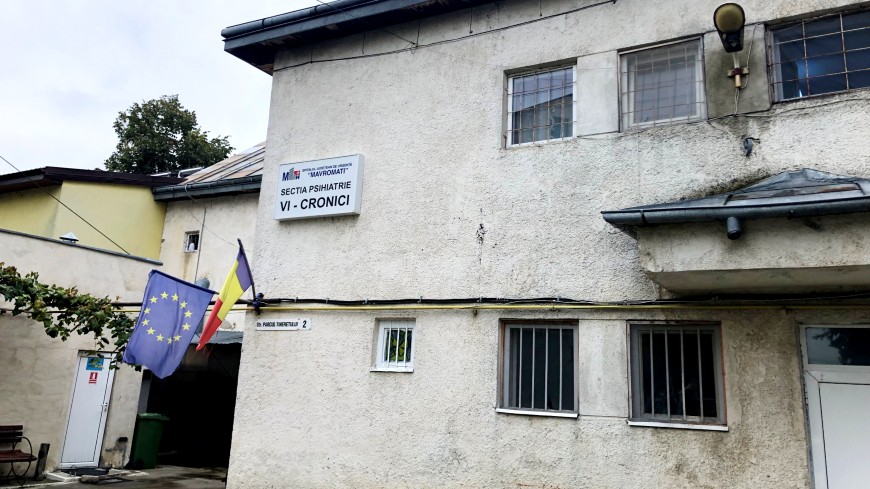Mental Health in Romania. A real problem especially after the Pandemic.
Marin Alexandra Ioana Iuliana
In Romania there is no department strictly responsible for mental health within the Ministry of Health. This puts pressure on professionals and poses a danger to patients and disabled people.
“There is no funding, there is no interest, there are no specialists and structures”, civil society representatives describe the way in which psychiatric conditions are approached in Romania.
Between September 19-30 2022, a delegation of the European Committee for the Prevention of Torture and Inhuman or Degrading Treatment or Punishment (CPT) visited several psychiatric institutions in Romania, with the aim of examining the treatment of patients.
The unannounced visit focused mostly on long-term inpatients and those with chronic illnesses. In addition to the attention given to hospitals, the commission also visited four residential centers, a first in Romania. The conclusions were then presented to the Romanian authorities and are to be published in an official report.
This was the committee’s 13th visit to Romania, the seventh unannounced. Although the committee’s observations have not yet been made public, the committee is not known for positive reviews.
The last visit of the committee was in February 2018, when they observed the conditions in several penitentiaries in the country. The report published later criticized the treatment applied to persons deprived of their liberty.
Five years before the incident at Săpoca Hospital, when a patient killed six other patients, the CPT visited this hospital, criticizing the conditions in the institution. In 2014, the CPT had warned that the treatment at Săpoca was strictly based on drug therapy, and the staff was insufficient.
When it comes to psychiatric institutions, the committee against torture has criticized Romania in the past for the conditions in hospitals, the lack of staff, overcrowding and the lack of initiative by the authorities.And this still hasn’t really changed even today. No changes have been truly made to change this aspect in any way, the people who are truly suffering especially are mostly the poor who can’t pay psychiatrists the high price they demand for consultation and let’s not even mention the people who have been involuntarily hospitalized.
Because one of the biggest problems, for which Romania was reprimanded by the European institutions in the past, is that of involuntary internments.
The law, regarding involuntary admissions, is clear: “The involuntary admission procedure applies only after all attempts at voluntary admission have been exhausted.” Georgiana Pascu explained that patients’ rights are not respected when it comes to involuntary admissions.
“They are taken to court in queues, dozens of patients are grouped together, they don’t have a lawyer and they don’t know how to challenge the involuntary admission decision,” she explains. Lack of appropriate procedural adaptations often leaves patients vulnerable. They do not know the law and are left to defend themselves against a forced internment decision.
The problem, says the expert, is that people are often taken to court “in pajamas and robes, sedated, stressed,” which can compromise their case. “There are people who don’t understand the questions, there are people who don’t know what to answer,” she explains.
In reality there should be procedural adaptations that allow patients to have assistants or mediators with them to explain the process and communicate with the courts for them. This does not happen in Romania.
22 years in residential center for adults with disabilities
Thus, once the court process is compromised, patients can end up hospitalized for years. Georgiana Pascu tells about a former patient from a residential center for adults with disabilities who was hospitalized for 22 years in a psychiatric hospital.
Other reasons for prolonged hospitalization are the lack of residential and social assistance services. “Poverty, lack of family, vulnerable social condition” are just some of the reasons why a visit to a psychiatric hospital could be prolonged.
“And this can also be seen with the naked eye in psychiatric hospitals, especially in rural areas, external wards or hospitals for the chronically ill, where there are people hospitalized for years or decades”, says Georgiana Pascu from her field experience.
The latest available data on involuntary hospitalizations comes from the CNSMLA website, according to which, in 2020, 4,998 people were involuntarily hospitalized and the cost of the hospitalizations was over 100 million lei.
The problem of the lack of social integration programs is well known to all who work in the system. The President of the National Association for Patient Protection, Vasile Barbu, explains that patients do not have the chance to be released and kept under observation at home.
“We do not even think of the problem of psychiatric patient reintegration” – Vasile Barbu, ANPP.
“His illness is not being addressed properly. Neither therapeutic, nor as a recovery program, nor social”, explains Barbu. The patient’s chances of recovery are affected by the lack of infrastructure. “It is a drama in a family to have such a patient. He can be integrated into the family and society, with monitoring, with permanent treatment,” he says.
However, in Romania there is no mechanism to support social reintegration.
“There are all kinds of events in a person’s life that at some point create a crisis and atypical behavior. He is immediately diagnosed as a madman,” he explains. And once in the system, the patient can spend a lot of time there, being deprived of access to social integration programs.
In a recent case, R.D. and I.M.D. v. Romania (35402/14), the CEDO condemned Romania for the hospitalization of a couple from Ștei in a psychiatric hospital, based on a medical-psychiatric examination carried out three years before, resulting in a long-term hospitalization and treatment which the two opposed.

An example of the lack of Mental Health in Romania.
Lack of reactions from the authorities
Georgiana Pascu emphasizes the lack of interest shown by the authorities: “It’s as if these problems don’t exist in Romania. I don’t know why but it shows the interest in this field and it’s a shame.”
According to the Situation Analysis carried out by the National Institute of Public Health in 2021, in Romania the incidence of mental and behavioral disorders was 2592.3 per 100,000 inhabitants, for the period 2009-2019.
The OMS, an organization of which the current Minister of Health, Alexandru Rafila, was part of as a member of the Executive Committee, raised alarm signals, regarding mental health, especially depression, and Romania’s responsibility to create special services following the Covid pandemic. These recommendations were also not implemented.
This is especially concerning considering the effects that the COVID pandemic has had on the population mentally not only in Romania, but in the entire world.Suicide rates reflect the mental health status in certain countries or regions. As the COVID-19 infection developed as a pandemic and governments imposed certain measures to stop the spread of the virus, mental health was affected worldwide. Romania was no exception as the government issued a complete lockdown with restrictions regarding travels, social gatherings, transition to working from home and others. The increase in the rate of unemployment, the difficulties in accessing the health services and the social distancing generated by the restrictions had a major impact on lifestyle with a potential surge of psychiatric disorders, with or without history of illness.
THE COVID-19 PANDEMIC
The COVID-19 pandemic had a major impact on all of life’s domains through the restrictions meant to slow its spreading and diminish its impact on public health. The government-imposed regulations reflected on the population by increasing the levels of social isolation, by changes in work environment and even unemployment (International Labor Organization, Citation2020). Along these, quarantines and lockdowns had negative psychological effects (Brooks et al., Citation2020). The unexpected occurrence of these events, along with their enforcement through legal measures, generated an increase of mental health problems in the general population.
A number of studies correlated previous outbreaks (SARS, MERS, Ebola, etc.) with an increase in suicides and suicidal behaviors (Wasserman, Citation1992; Yip, Cheung, Chau, & Law, Citation2010; Zortea et al., Citation2021), possibly triggered by the preventative measures that determine a decrease in social integration and human interaction. Although at the beginning of the outbreaks the feelings of social adhesion and integration are elevated, they decrease in time and turn into a risk factor for suicidal ideation (Claassen et al., Citation2010).
Ran et al. demonstrates that a large number of people exhibit a significant distress caused by the pandemic, and some present depressive or anxiety symptoms. These results were later confirmed by a series of studies (Choi, Hui, & Wan, Citation2020; Ran et al., Citation2020; Rehman et al., Citation2021). Ahmed et al. suggested that a decreased level of mental health during the pandemic is associated with an increased incidence of anxiety, depression and alcohol use disorders, these being risk factors for suicide behavior (Ahmed et al., Citation2020). Hao et al. compared the impact of the pandemic on the mental health of psychiatric patients with the general population (Hao et al., Citation2020). The results indicated that the distress generated is greater in people with psychiatric pathology and, furthermore, it can lead to an increase in suicidal ideation.
The pandemic and the measures intended to slow its spread generated a context that can lead to an increased risk for suicidal ideation and behavior, especially in certain susceptible groups such as those with genetic predisposition (Matei et al., Citation2020), psychiatric illnesses (Bertolote, Fleischmann, De Leo, & Wasserman, Citation2004), personality traits (Brezo, Paris, & Turecki, Citation2006) and others. Therefore, loneliness, anxiety, distress and the economic changes caused by the restrictions can produce a direct impact on mental health and possibly an increase in the number of suicides. Furthermore, the increased levels of stress and the sudden changes in lifestyle can trigger psychiatric illnesses, even in those with no history (Kendler, Karkowski, & Prescott, Citation1999; Kendler et al., Citation1995).
The interpersonal theory of suicide, developed by Joiner, suggests that hopelessness is both a risk factor and a predictor of suicide ideation. There are two key elements that generate the lack of hope—thwarted belongingness and perceived burdensomeness (Joiner, Van Orden, Witte, & Rudd, Citation2009). Social distancing, the restriction of social events, and changes in the work environment, work-at-home jobs in particular, increase the thwarted belongingness by decreasing, and sometimes eliminating social interactions. Also, the impact on the economic area and the increase of unemployment creates financial problems and can increase the perceived burdensomeness (National Institute of Statistics, Citation2021). This perspective on the causality of suicide ideation is confirmed by other studies. Quebec Health Survey highlighted that distancing measures and the lack of friends could cause an increase in suicide ideation and in the number of suicide attempts (Stravynski & Boyer, Citation2001). Furthermore, an increase in suicidality was observed in the context of financial uncertainty (Vandoros, Avendano, & Kawachi, Citation2019).
In Romania, the first recorded case was in late February 2020, followed one month later by a generalized lockdown imposing travel restrictions, banning events involving the participation of a large number of people, closing public spaces (restaurants, cinemas, gyms, etc.), closing many workplaces with a partial transition to work from home, increasing the unemployment rate in the general population and making it more difficult to access medical services, including outpatient ones before the regulation of telemedicine. These major changes, with a progressive but constant impact on lifestyle, have the potential to cause a wave of psychiatric pathologies, both through relapses among psychiatric patients and the development of pathologies among the healthy population. By delaying the therapeutic intake due to the pandemic by overloading the health services as well as by the implemented legal restrictions, these pathologies could worsen and give rise to suicidal ideation and suicidal behavior (Stoean, Dima, Buciuta, & Cozman, Citation2020).
In total, there had been 858 patients with suicide attempts in the last 5 years. Of these, 468 had suicide attempts and 390 were completed suicides.
Number of Suicide Attempts and Completed Suicides
In 2020, at the level of Cluj County, 170 suicide attempts and completed suicides took place in Cluj County, similar to the average of previous years (172).
The number of completed suicides decreased compared to the average of previous years (69 vs. 80.25) but with an increase in the number of suicide attempts hospitalized in the Psychiatric Clinic increased (101 vs. 91.75).Although the total number of hospitalizations decreased by 29.15% compared to the previous years (2497 in 2020 vs. 3525 on average during 2016–2019), a relative increase in the number of suicide attempts was reported in relation to the number of hospitalizations (4.04 vs. 2.60%, p = 0.048).Which is a pretty bad increase in the number of suicides ,but not unexpected considering the event that is the Pandemic, tho this is only data from the first year in which it took place, afterall information overload, rumors and misinformation can make your life feel out of control and make it unclear what to do, and there was plenty of that during COVID-19.
In conclusion, Romania needs to step up and provide better mental health services, before more people leave the country for better health services, employment pay and other better amenities other countries may have , if it wants to still have citizens after everything is said and done.
For example professors should not feel the need to rally against the government for better pay like they do right now in the present and this week, it has been already 2 full days of them demanding better pay , since they have a little salary and they learn and work as hard as doctors who have a much higher salary over them. In a prosperous and good country normally this should not happen.Unfortunately Romania doesn’t really make that category in the present.It will only hit that bar when the government starts listening better to the people as a whole and respects and puts in consideration their demands. That’s all I have to say for now.




